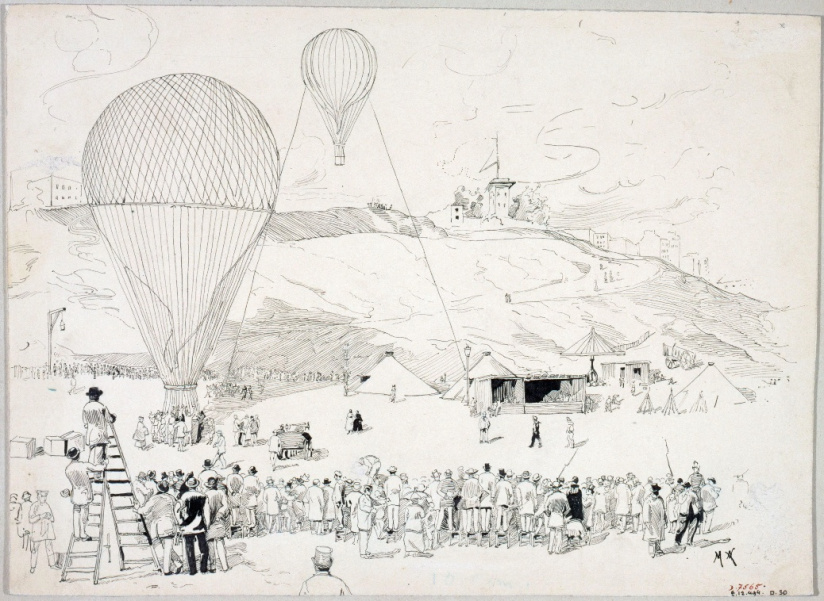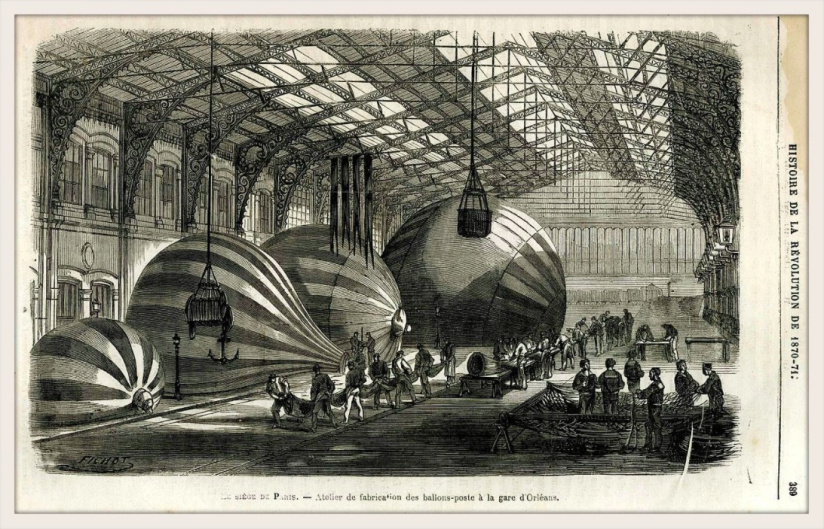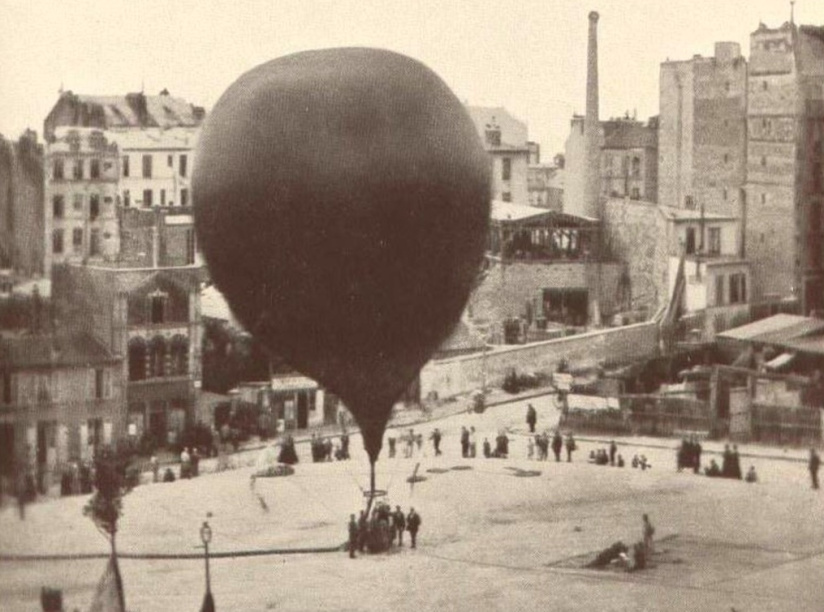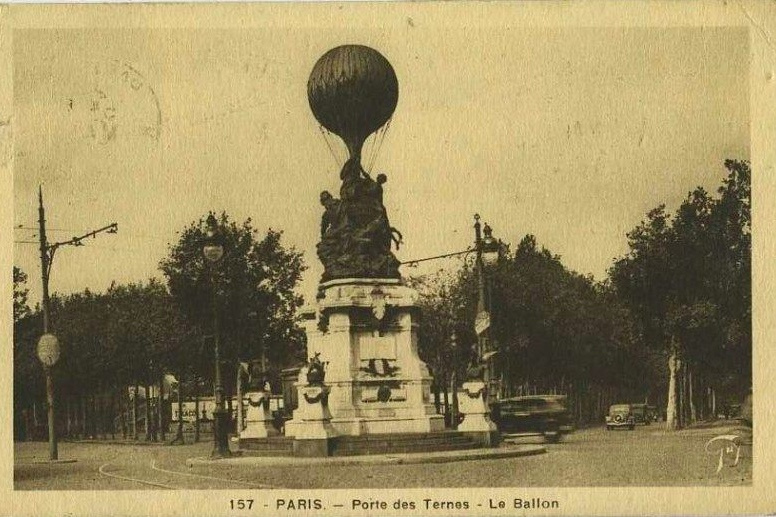On Friday September 23, 1870, the first mounted balloon crossed the German lines during the Siege of Paris. Called Le Neptune, this first gas balloon, followed by 65 others until January 28, 1871, carried 125 kilos of official dispatches, newspapers and letters to the Château de Cracouville, near Évreux. This was the beginning of the airmail service.
Paris has been under German rule for three days. Following the overthrow of Queen Isabella II of Spain during La Gloriosa, the popular Spanish revolution of 1868, Prince Leopold of Hohenzollern-Sigmaringen, cousin of the King of Prussia, was approached to replace the exiled sovereign in France, despiteNapoleon III's opposition. On July 19, 1870, France declared war on Prussia.
But the French armies, only 300,000 strong, were unprepared for such confrontations, and suffered rout after rout, culminating in the defeat of French troops at Sedan on September 2, 1870, by Prussian troops and their allies, and the capture of Napoleon III.
Two days later, the Third Republic was proclaimed in Paris by Léon Gambetta , and a Government of National Defense was hastily set up. But the situation in France did not improve, and enemy troops continued their rapid advance north of the Loire towards the capital, without encountering much opposition.
By September 17, 1870, Paris was encircled by the Germans, and on September 19 was placed under siege, marking the start of the Siege of Paris. Communications with the rest of the country were cut off, and the government quickly had to devise a way ofgetting civilian and military mail out of the capital. The solution was obvious: for want of an overland route, mail would be sent by air.
Experienced balloonist and French engineer Claude Jules Dufour, known as Duruof, was commissioned by Germain Rampont, Director General of the French Post Office, to design balloons for airmail, with the help of Parisian photographer and engineer Félix Tournachon, known as Nadar, founder of the Compagnie des Aérostiers militaires. Tournachon, who had developed a passion for balloons, had already been building tethered balloons since the start of the conflict, , to observe enemy lines and adjust fire.
On September 19, 1870, Léon Gambetta, now Minister of the Interior, signed an agreement ordering the construction of three aircraft in the Gare d'Austerlitz and Gare du Nord railway stations, which had been requisitioned for the occasion. marked the beginning of the aeronautical industry. But for the first flight, it was decided that an existing balloon available in Paris would be used. Nadar's balloon Le Neptune, which had already made a dozen observation flights in the preceding days, was chosen.
At 8 a.m. on Friday September 23, 1870, Le Neptune, which had been re-inflated during the night from a gas pipe used to light street lamps, took off from Place Saint-Pierre before the eyes of the elected members of the Government of National Defense and the crowd gathered at the foot of the Butte Montmartre, after Nadar had shouted "Lâchez tout!" to the soldiers holding the ropes. Loaded with 125 kg of letters and dispatches destined for members of the government who had retreated to Tours, the balloon was piloted by Duruof, the only person on board, who knew the craft well, having been its first owner.
The Neptune crossed enemy lines over Versailles and headed for Le Havre, as the German army had not yet reached Normandy. The aircraft flew 104 kilometers without a hitch before landing, after 3 hours and 15 minutes in the air, in the park of the Château de Cracouville, near Évreux in Normandy. This was the very first flight in theworld history of aeropostale. On learning of the trip, Otto von Bismarck is said to have exclaimed, "This is not fair!
Thereafter, 65 aircraft would leave Paris until the end of the Siege of Paris and the signing of the armistice on January 28, 1871, carrying more than a hundred passengers and between 2.5 and 3 million official and private letters, envelopes and other dispatches to points beyond the Paris Basin, out of range of Prussian guns. Inflated with highly flammable lighting gas, the balloons soared day and night, taking fire from enemy troops.
To manage them, the government recruited gymnasts and sailors as volunteers, as there were no aeronauts available. Trained on the ground in the rudiments of aerostation, they took to the skies in aircraft with little experience. Gambetta himself took off in the Barbès balloon on October 7, 1870, to join the Provisional Government Delegation in Tours to organize the country's defense. Fortunately, as the months went by, the balloons proved their reliability, with only three failures in over 60 flights.
Nevertheless, travel was no easy matter, subject as it was to the direction and strength of the wind. The aerostat Le Duquesne landed in an occupied zone, the Ville de Paris landed in Germany, Le Jacquart sank in the waters south of England and Le Daguerre was machine-gunned by the Prussians, its two passengers being taken prisoner. But the record was held by the Ville d'Orléans balloon, which covered 1,246 kilometers before finally landing in Norway!
In memory of these aerial successes, the Ballon des Ternes, a work by sculptor Frédéric-Auguste Bartholdi representing the City of Paris, with a child on its knees reaching out to a pigeon bringing news of the country, and topped by an imposing copper balloon, was erected in 1906 at the Porte des Ternes, the departure point for many balloon flights. The monument was melted down by the Germans during the Second World War.
Find out more:
If you too would like to see Paris from above and feel like a balloonist, climb into the Ballon de Paris, located in the Parc André-Citroën in the 15th arrondissement. The view is breathtaking!
Location
Place Saint-Pierre
Pl. Saint-Pierre
75018 Paris 18
More information
Iconography: Departure of the balloon Le Neptune, place Saint-Pierre-de-Montmartre































